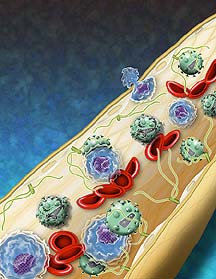|
(page 2 of 2)
The capture of virus by syndecans and their role as in trans
receptors has had a profound impact on how Gallay and others
think about HIV pathogenesis.
In his most recent study, Gallay and his colleagues found
that various subtypes of HIV, including HIV-1 and HIV-2, and
even related lentiviruses, like simian immunodeficiency virus
(SIV) use syndecans as in trans receptors for entry.
"Syndecans not only capture HIV—they protect it as
well," says Gallay.
Normally, free virus loses its ability to infect cells relatively
quickly in the bloodstream as it is exposed to proteases,
chemicals, and components of the immune system. But while
free virions lose their activity after a single day, those
bound to the long chains of the syndecans on the outside of
cells are protected from the proteases and other blood components,
and remain infectious for up to a week.
During this week, syndecans can present the virions to passing
CD4+ T cells, potentially infecting them. Moreover, Gallay
and his colleagues showed that the syndecans not only present
the virions, they actually enhance their infectivity because
they concentrate the virus into certain anatomical hot spots.
This is especially significant because syndecans are broadly
expressed by the body's cells in the inside surface of blood
vessels and other tissue similarly lined with endothelial
cells. Endothelial cells are one of the major cell types of
the body, accounting for about one percent of the total cells
in the body—approximately 600 square meters of surface
area.
"We found that all of the endothelium is rich in these syndecans,"
says Gallay.
Significantly, endothelial cells that line the adenoids,
tubing that connects the lymph nodes to the blood stream,
are literally covered with syndecans—meaning that they
may also be covered in virus. This is very important, says
Gallay, because as T cells go in and out of the lymph nodes,
they may be picking up the virus.
Now he is attempting to generate with phage display antibodies
that target the part of the HIV GP120 coat protein that interacts
with the heparin sulfate chains. This will not only help him
identify the particular domains of GP120 to which the heparin
sulfate chains bind, but the antibodies that might interrupt
the interaction of syndecans with HIV, preventing attachment
of HIV to these cells.
"The final goal is to prevent the virus from being protected
by the endothelial wall and see if the virus will be rapidly
degraded," says Gallay.
Significantly, such antibodies might also be relevant as
a starting point for prophylactic protection against HIV.
Gallay notes that syndecans are particularly richly expressed
on genital epithelial cells, where they can rapidly accumulate
the virus—something that may be relevant for the initial
transmission of the virus into the bloodstream.
"I think the best place [to attempt to] block transmission
of the virus is in this initial stage," says Gallay. "We hope
to find drugs or antibodies that disrupt transmission into
the blood stream."
1 | 2 |

|

This model illustrates how syndecans
expressed on the endothelial lining of the vasculature facilitate
HIV infection of circulating T lymphocytes. To avoid degradation
in the bloodstream, HIV (colored green) rapidly attaches to
the surface of the endothelium via the long anionic heparan
sulfate chains of the syndecans (in yellow). Once bound, HIV
is either retained in an infectious state for several days,
or is transmitted to circulating T cells (colored blue).
Illustration by Peggy Myer, Biomedical
Graphics.
|

